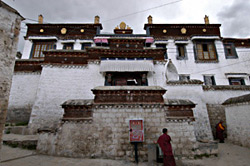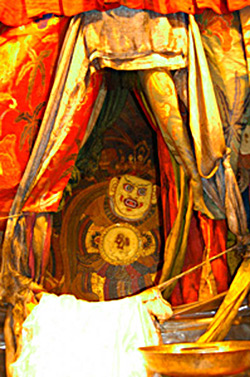by Georges Dreyfus and THL.
The Deyang Monastic College (Deyang Dratsangbde yangs grwa tshang)
DeyangBde yangs is the smallest of the three philosophical monastic colleges that have survived at Drepung’Bras spungs. It has a number of intriguing characteristics such as a curriculum that differs from most of the other colleges and a close connection to the Dalai Lama (Talé LamaTā la’i bla ma) in general and the Fifth (Ngapalnga pa) in particular. Despite this connection, DeyangBde yangs has remained a small college, with perhaps as many as six hundred monks in the 1950s. Because of its small size, DeyangBde yangs never adopted the system of regional houses of the larger colleges, but just built a few large apartment houses (chikhangspyi khang) to house its monks. Its administrative structure was also much simpler than that of larger colleges, with an abbot appointed by the Dalai Lama’s government, a disciplinarian in place for six months, a chanting master and a council composed of the four stewards of the college.

Entrance to the DeyangBde yangs Temple Complex
DeyangBde yangs was founded in 1440 by Chokpa Jangchup PendenLcog pa byang chub dpal ldan (1404-? CE), a KadamBka’ gdams monk who had studied at RadrengRwa sgreng and DrakyerpaBrag yer pa. Jangchup PendenByang chub dpal ldan was a student of Chennga RinpochéSpyan snga rin po che, a KadamBka’ gdams master, who wrote two histories of this tradition. He also became the student of Jamyang Chöjé’Jam dbyangs chos rje, who entrusted him with the leadership of one of the seven colleges that were being created to accommodate the growth of the monastic population during the first half of the fifteenth century. Drepung’Bras spungs was then divided into seven colleges specialized by subjects. Gomang and LosellingBlo gsal gling, which became the larger colleges, devoted themselves to the study of the prajñāpāramitā literature and madhyamaka philosophy, whereas DeyangBde yangs was consecrated to the study of logic and epistemology. Hence, DeyangBde yangs gave priority to the study of Dharmakīrti’s Pramāṇavārttika, the main Indian Buddhist text on this topic. It was the first major text studied by the monks engaged in the scholastic curriculum, contrary to the two other colleges where the Abhisamayālaṃkara was given priority. It was also the text on which monks spent the greatest amount of time (up to six years), with each of the four chapters of the text being examined in great details. After finishing the study of this text, students examined the other major subjects, starting with the prajñāpāramitā literature and madhyamaka philosophy. After four more years to master these two major topics, they completed their curriculum with the study of the abhidharma and the Discipline.
Another interesting characteristic of the scholastic culture of this college was its adoption of some of the texts written by the Fifth Throne-Holder of Drepung (Drepung Tripa Ngapa’bras spungs khri pa lnga pa) as its scholastic manuals. This was mostly for the study of the prajñāpāramitā literature and madhyamaka philosophy where the texts written by this great leader played a central role, whereas for logic and epistemology, Penchen Sönam DrakpaPaṇ chen bsod nams grags pa’s and Gendün DrupDge ’dun grub’s (1391-1474 CE) texts were considered authoritative. The reasons and circumstances under which these texts were adopted are unknown to this writer. One cannot but wonder, however, whether the adoption of the Fifth’s (Ngapalnga pa) texts and the close connection with this important figure symbolized by the adoption of these texts played a role in the continuous existence of this college, which survived despite its modest size. This contrasted with the fate of the other small colleges, which were absorbed into the larger colleges during the eighteenth century. Gomang absorbed the Vinaya Monastic College whereas ShakkorShag skor and GyepaRgyas pa became part of LosellingBlo gsal gling. Only DeyangBde yangs survived.

NechungGnas chung in the Maitreya Chapel
A close connection with the Dalai Lama (Talé LamaTā la’i bla ma) and his government was also clear in the protectors that the monastery propitiated, NechungGnas chung and the Great Goddess (Penden LhamoDpal ldan lha mo). NechungGnas chung is a worldly deity, one in an important group of five deities named The Five Kings (Gyelpo KungaRgyal po sku lnga lit., the five king-bodies) who are considered to be the manifestations of PeharPe har, the deity appointed by Padmasaṃbhava (Padma JungnéPadma ’byung gnas, 8th Century-? CE) as the main guardian of Buddhism in Tibet. the Great Goddess is a supra-mundane deity, the Tibetan equivalent of Mahādevī, the powerful goddess who protects her followers. Since the time of the Fifth Throne-Holder of Drepung (Drepung Tripa Ngapa’bras spungs khri pa lnga pa), these two deities have been the official protectors of the Dalai Lama (Talé LamaTā la’i bla ma) and the Tibetan Government and are known as “the red and black protectors” (sungma marnak nyisrung ma dmar nag gnyis). They were also the protectors of DeyangBde yangs. This is probably more than a coincidence and may explain the survival of this small college.
DeyangBde yangs was not, however, the temple where NechungGnas chung was being officially propitiated, for this honor was reserved to the NechungGnas chung monastery just below Drepung’Bras spungs. According to a legendary account, PeharPe har had been propitiated at Tsé GungtangGung thang when a local lamabla ma decided to stop the practice. He placed the deity in a wooden box and threw it in the KyichuSkyid chu, the river that flows through LhasaLha sa. Jangchup PendenByang chub dpal ldan saw the deity floating toward Drepung’Bras spungs and ordered his steward to recuperate the box and bring it to the monastery without opening it. But, as it is often the case in narratives, he was not obeyed and the box was open prematurely just below Drepung’Bras spungs. NechungGnas chung came out of the box under the form of a black crow and merged into a tree. It is on this spot that the monastery officially in charge of its propitiation was established.
If DeyangBde yangs managed to survive for a long time, its fate has been more difficult in recent times when it became engulfed in the difficult political events that overtook Drepung’Bras spungs and the whole of the Tibetan world. These events have affected DeyangBde yangs more than the other colleges. Since very few of its monks made it into exile, it has been unable to reestablish itself in India. In Tibet, monastic colleges have not been functioning as semi-independent institutions, as they used to do. Hence, DeyangBde yangs, like the other colleges, is not fully functioning and with its small population it has found it difficult to maintain its traditions. Nevertheless, it reopened its old temple. Although the content of its Assembly Hall was entirely destroyed during the Cultural Revolution, its building was saved by being used as a store-house. Hence, it has been able to function as one of the several temples that pilgrim visit when they come to Drepung’Bras spungs. The college is also attempting to revive some of its traditions, such as the practice of the Medicine Buddha (MenlaSman bla), which used to be one of the monastery’s main ritual practices. Similarly, the Protector (Gönkhangdgon khang) has been refurbished with new statues made to the old specifications and the practices of protectors, particularly those connected with NechungGnas chung, are being revived.
Drepung Monastery Home
Table of Contents
- The Gomang Monastic College
- The Loselling Monastic College
- The Deyang Monastic College
- The Tantric Monastic College
- Glossary
- Specify View:
- Specify Format:
 |  |  |